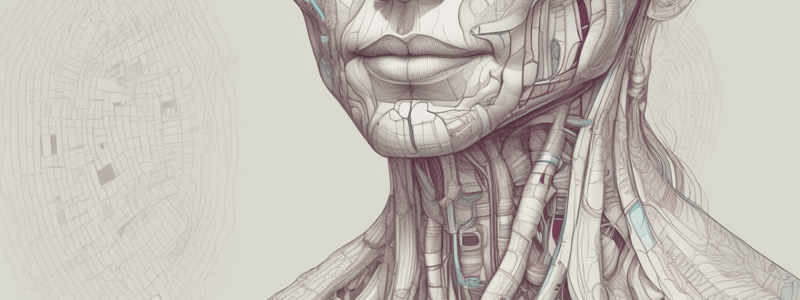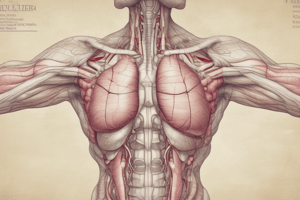Podcast
Questions and Answers
What is the shape of follicular cells in the thyroid gland when deactivated?
What is the shape of follicular cells in the thyroid gland when deactivated?
- Fibroblastic
- Columnar
- Cuboidal
- Squamous (correct)
What is the primary function of thyroglobulin in the thyroid gland?
What is the primary function of thyroglobulin in the thyroid gland?
- Stimulates the release of TSH from the pituitary gland
- Regulates iodine balance in the body
- Acts as a prohormone for T3
- Serves as a scaffold for thyroid hormone synthesis (correct)
Which of the following is NOT a dietary source of iodine?
Which of the following is NOT a dietary source of iodine?
- Fish and shellfish
- Cereal and grains
- Milk and dairy products
- Red meat (correct)
What is the daily physiological requirement of iodine in adults?
What is the daily physiological requirement of iodine in adults?
What is the process of adding iodine to an organic benzene ring called?
What is the process of adding iodine to an organic benzene ring called?
Which of the following regions is at risk for iodine deficiency?
Which of the following regions is at risk for iodine deficiency?
What is the primary reservoir of thyroid hormones in the body?
What is the primary reservoir of thyroid hormones in the body?
What is the most active form of thyroid hormone?
What is the most active form of thyroid hormone?
In the process of thyroid hormone synthesis, what is the primary role of thyrocytes?
In the process of thyroid hormone synthesis, what is the primary role of thyrocytes?
What is the primary function of thyronine-specific deiodinases in the peripheral tissues?
What is the primary function of thyronine-specific deiodinases in the peripheral tissues?
What is the result of the Wolff-Chaikoff effect?
What is the result of the Wolff-Chaikoff effect?
What is the primary mechanism of regulation of thyroid hormone secretion?
What is the primary mechanism of regulation of thyroid hormone secretion?
What is the effect of TRH on the anterior pituitary gland?
What is the effect of TRH on the anterior pituitary gland?
What is the effect of TSH on the thyroid gland?
What is the effect of TSH on the thyroid gland?
What is the primary role of TSH receptors in the thyroid gland?
What is the primary role of TSH receptors in the thyroid gland?
What is the result of the interaction between thyroid hormones and their receptors?
What is the result of the interaction between thyroid hormones and their receptors?
Flashcards are hidden until you start studying
Study Notes
Anatomy of the Thyroid Gland
- The thyroid gland can be easily palpated.
Histology of the Thyroid Gland
- Follicular cells can vary in height and shape, being cuboidal or columnar when activated and squamous when deactivated.
- Thyroglobulin is a glycoprotein.
Hormones of Thyroid Gland
- Thyroglobulin serves as a scaffold for thyroid hormone synthesis.
- T4 acts as a prohormone for T3, which is biologically active.
Iodine Balance
- Iodine is a trace element in soil and water, and can be found in seafood.
- Iodine deficiency is the world's greatest single cause of preventable brain damage and mental retardation.
- Dietary sources of iodine include:
- Some fruit and vegetables, with concentration dependent on soil iodine levels.
- Cereal and grains, with concentration dependent on soil iodine levels.
- Milk and dairy products.
- Fish and shellfish.
- Regions at risk for iodine deficiency include:
- Northern Indian subcontinent.
- Andean region in South America.
- Mountainous regions of Europe, China, and Africa.
- The daily physiological requirement of iodine in adults is 150ug.
Generation of Thyroid Hormones
- Iodide is absorbed from the diet.
- Organification involves adding iodine to an organic benzene ring.
Steps in Thyroid Hormone Synthesis
- TSH is released by the pituitary gland.
Key Points of Thyroid Hormone Synthesis
- Thyroid hormones contain large amounts of iodine, which must be adequately supplied in the diet.
- Synthesis of thyroid hormones is partially intracellular and partially extracellular.
- Colloid is a reservoir of thyroid hormones, allowing humans to survive for up to 2 months without iodine in their diet.
- Although T4 is the major secretory product, T3 is the most active form of the hormone.
- Thyrocytes collect and transport iodine, synthesize thyroglobulin, fix iodine to thyroglobulin, and secrete thyroid hormones into the circulation.
Thyronine-Specific Deiodinases
- Almost all hormonal output of the thyroid gland is T4, which is converted to T3 in peripheral tissues through the action of thyronine-specific deiodinases.
- Deiodinases regulate the conversion of T4 to T3 in peripheral tissues and the conversion of T4 and T3 to inactive metabolites.
Regulation of Thyroid Hormone Secretion
- Specific feedback mechanisms operate through the hypothalamus and anterior pituitary gland to control the rate of thyroid secretion.
- Regulation of thyroid hormone secretion is under negative-feedback control.
- TRH and TSH are released at different times.
Regulation of Thyroid Hormone Secretion - TRH
- TRH stimulates the anterior pituitary gland cells to increase their output of TSH.
- TRH receptors activate the phospholipase second messenger system.
Regulation of Thyroid Hormone Secretion - TSH
- TSH stimulates the thyroid follicular cells to secrete thyrotropines.
- TSH receptors activate the cAMP second messenger system.
- Effects of TSH on the thyroid gland include:
- Increased proteolysis of thyroglobulin.
- Increased rate of "iodide trapping".
- Increased iodination of tyrosine to form thyroid hormones.
- Increased size and secretory activity of the thyroid cells.
- Increased number of thyroid cells, with a change from cuboidal to columnar cells.
Studying That Suits You
Use AI to generate personalized quizzes and flashcards to suit your learning preferences.



